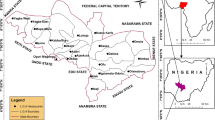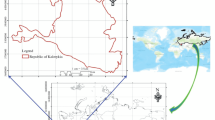Abstract
Groundwater potential zones were demarcated with the help of remote sensing and Geographic Information System (GIS) techniques. The study area is composed rocks of Archaean age and charnockite dominated over others. The parameters considered for identifying the groundwater potential zone of geology slope, drainage density, geomorphic units and lineament density were generated using the resource sat (IRS P6 LISS IV MX) data and survey of India (SOI) toposheets of scale 1:50000 and integrated them with an inverse distance weighted (IDW) model based on GIS data to identify the groundwater potential of the study area. Suitable weightage factors were assigned for each category of these parameters. For the various geomorphic units, weightage factors were assigned based on their capability to store ground-water. This procedure was repeated for all the other layers and resultant layers were reclassified. The reclassified layers were then combined to demarcate zones as very good, good, moderate, low, and poor. This groundwater potentiality information could be used for effective identification of suitable locations for extraction of potable water for rural populations.
Similar content being viewed by others
References
Anithamary I, Ramkumar T, Venkatramanan S (2012). Application of statistical analysis for the hydrogeochemistry of saline groundwater in Kodiakarai, Tamilnadu. Journal of Coastal Research, 28(1A): 89–98
Asadi S S, Vuppala P, Reddy M A (2007). Remote sensing and GIS techniques for evaluation of groundwater quality in municipal corporation of Hyderabad (Zone-V), India. Int J Environ Res Public Health, 4(1): 45–52
Bahuguna IM, Nayak S, Tamilarasan V, Moses J (2003). Groundwater prospective zones in basaltic terrain using remote sensing. J Indian Soc Remote Sens, 31(2), 101–105
Butler M, Wallace J, Lowe M (2002). Ground-water quality classification using GIS contouring methods for Cedar Valley, Iron County, Utah. In: Proceedings of Digital Mapping Techniques, 2002 Workshop, US Geological Survey Open-File Report 02-370
Central Groundwater Board (CGWB) (2008). District Groundwater Brochure, Kodikanal, Dindigul district, Tamilnadu. Technical Report 1-23
Chi K H, Lee B J (1994). Extracting potential groundwater area using remotely sensed data and GIS techniques. In: Proceedings of the Regional Seminar on Integrated Applications of Remote Sensing and GIS for Land and Water Resources Management, Bangkok. Bangkok: Economic and Social Commission for Asia and the Pacific, 64–69
Dawoud M A, Darwish M M, El-Kady M M (2005). GIS-based groundwater management model for western Nile delta. Water Resour Manage, 19(5): 585–604
El-Hames A S, Al-Ahmadi M, Al-Amri N (2011). A GIS approach for the assessment of groundwater quality inWadi Rabigh aquifer, Saudi Arabia, Environ. Earth Sci, 63(6): 1319–1331
Hrkal Z (1992). Acidification of groundwater in the Bohemian Massif. Nor Geol Unders Bull, 422(7): 97–102
Hrkal Z (2001). Vulnerability of groundwater to acid deposition, Jizerske Mountains, northern Czech Republic: construction and reliability of a GIS-based vulnerability map. Hydrogeol J, 9(4): 348–357
Jaiswal R K, Mukherjee S, Krishnamurthy J, Saxena R (2003). Role of remote sensing and GIS techniques for generation of groundwater prospect zones towards rural development-an approach. Int J Remote Sens, 24(5): 993–1008
Karanth K R (1987). Ground Water Assessment Development and Management. New York: McGraw-Hill
Krishnamurthy J, Venkatesa Kumar N, Jayaraman V, Manivel M (1996). An approach to demarcate groundwater potential zones through remote sensing and a GIS. Int J Remote Sens, 17(10): 1867–1884
Leblanc M, Favreau G, Tweed S, Leduc C, Razack M, Mofor L (2007). Remote sensing for groundwater modeling in large semiarid areas: Lake Chad basin, Africa. Hydrogeol J, 15(1): 97–100
Lokesha N, Gopalakrishna G S, Honne Gowda H, Gupta A K (2005). Delineation of groundwater potential zones in a hard rock terrain of Mysore district, Kamatak using IRS data and GIS techniques. J Indian Soc Remote Sens, 33(3): 405–412
Magesh N S, Chandrasekar N, Soundranayagam J P (2012). Delineation of groundwater potential zones in Theni district, Tamil Nadu, using remote sensing, GIS and MIF Techniques. Geoscience Frontiers, 3(1): 189–196
Mathes E S, Rasmussen T C (2006). Combining multivariate statistical analysis with geographic information systems mapping: a tool for delineating groundwater contamination. Hydrogeol J, 14(8): 1493–1507
Mohammed A, Balasubramanian A, Kondoh A, Rokhmatuloh R, Mustafa A J (2003). Hydrogeomorphological mapping using remote sensing techniques for water resource management around palaeochannels, geoscience and remote sensing symposium, IGARSS-APOS; 03. In: Proceedings of the 2003 IEEE International, Toulouse, France
Münch Z, Conrad J (2007). Remote sensing and GIS based determination of groundwater dependent ecosystems in the Western Cape, South Africa. Hydrogeol J, 15(1): 19–28
Pius A, Jerome C, Sharma N (2012). Evaluation of groundwater quality in and around Peenya industrial area of Bangalore, South India using GIS techniques. Environ Monit Assess, 184(7): 4067–4077
Prasad R K, Mondal N C, Banerjee P, Nandakumar M V, Singh V S (2008). Deciphering potential groundwater zone in hard rock through the application of GIS. Environ Geol, 55(3): 467–475
Rai B, Tiwari A, Dubey V S (2005). Identification of groundwater prospective zones by using remote sensing and geoelectrical methods in Jarla and Raniganj coalfields, Dhanbad district, Jharkhand state. J of Earth System Sciences, 114(5): 515–522
Ramkumar T, Venkatramanan S, Anithamary I, Syed Ibrahim S M (2011). Evaluation of hydrogeochemical parameters and quality assessment of the groundwater in Kottur blocks, Tiruvarur district, Tamilnadu, India. Arab J Geosciences, doi: 10.1007/s12517-011-0327-2
Rekha V B, Thomas A P, Suma M, Vijith H (2011). An integration of spatial information technology for groundwater potential and quality investigations in Koduvan Ár, sub-watershed of Meenachil River basin, Kerala, India. J Indian Soc Remote Sens, 39(1): 63–71
Rokade V M, Kundal P, Joshi A K (2007). Groundwater potential modeling through remote sensing and GIS: a case study from Rajura Taluka, Chandrapur district, Maharashtra. J Geol Soc London, 69: 943–948
Saha D, Dhar Y R, Vittal S S, (2010). Delineation of groundwater development potential zones in parts of marginal Ganga alluvial plain in south Bihar, eastern India. Environ Monitor, 165(1–4): 179–191
Sankar K (2002). Evaluation of groundwater potential zones using remote sensing data in upper Vaigai River basin, Tamil Nadu, India. J Indian Soc Remote Sens, 30(3): 119–129
Skidmore A K, Bijer W, Schmidt K, Kumar L (1997). Use of remote sensing and GIS for sustainable land management. ITC Journal, 3: 302–315
Skubon B A (2005). Groundwater quality and GIS investigation of a shallow sand aquifer, Oak opening region, Northwest Ohio. Geol Soc Am Abstr Programs, 7: 37–94
Solomon S, Quiel F (2006). Groundwater study using remote sensing and geographic information systems (GIS) in the central highlands of Eritrea. Hydrogeol J, 14(6): 1029–1041
Srinivasa R Y, Jugran K D (2003). Delineation of groundwater potential zones and zones of groundwater quality suitable for domestic purposes using remote sensing and GIS. Hydrol Sci J, 48(5): 821–833
Subramani T, Elango L, Damodarasamy S R (2005). Groundwater quality and its suitability for drinking and agricultural use in Chithar River basin, Tamil Nadu, India Environ Geol, 47(8): 1099–1110
Sujatha D, Rajeswara Reddy B (2003). Quality characterization of groundwater in the south-eastern part of the Ranga Reddy district, Andhra Pradesh, India. J Environ Geology, 44(5): 579–586
Tjandra F L, Kondhoh A, Mohammed M A (2003). A conceptual database design for hydrology using GIS. In: Proceedings of Asia Pacific Association of Hydrology and Water Resources, Kyoto
Vasanthavigar M, Srinivasamoorthy K, Vijayaragavan K, Gopinath S, Sarma S (2011). Groundwater potential zoning in Thirumanimuttar sub-basin Tamilnadu, India-a GIS and remote sensing approach, geo-spatial. Inf Sci, 14(1): 17–26
Venkatramanan S, Ramkumar T, Anithamary I (2012). A statistical approach on hydrogeochemistry of groundwater in Muthupet coastal region, Tamilnadu, India, Carpathian. Journal of Earth and Environmental Sciences, 7(1): 47–54
Vijith H (2007). Groundwater potential in the hard rock terrain of western Ghats: a case study from Kottayam district, Kerala using resourcesat (Irs-P6) data and GIS techniques. J Indian Soc Remote Sens, 35(2): 163–171
Vittala S, Govindaiah S, Gowda H H (2005). Evaluation of groundwater potential zones in the sub-watersheds of North Pennar River basin around Pavagada, Karnataka, India, using remote sensing and GIS techniques. J Indian Soc Remote Sens, 33(4): 483–493
Yammani S (2007). Groundwater quality suitable zones identification: application of GIS, Chittoor area, Andhra Pradesh, India. Env Geol, 53(1): 201–210
Author information
Authors and Affiliations
Corresponding authors
Additional information
Murugesan Bagyaraj obtained his M.Sc. degree in applied geology from Annamalai University, India. Now he is a Ph.D. candidate in the Department of Earth Sciences, Annamalai University. His research interest focuses on hydrogeology, remote-sensing and GIS in Kodaikanal, South India.
Thirunavukkarasu Ramkumar obtained his B.Sc., M.Sc., M.Sc (Hydrology), M. Phil., Ph.D degree from Annamalai University, respectively, M.Sc. (Environmental Science) from Nottingham University, UK. Now he is a Professor and Head in Department of Earth Sciences, Annamalai University, India. His expertise is in the area of environmental geochemisty, hydrogeology, sedimentology and remote-sensing and GIS. Prof. Ramkumar has published more than 30 peer-reviewed research articles in his research area.
Senapathi Venkatramanan obtained his B.Sc. degree in geology from Madurai Kamaraj University, India; M.Sc. (Applied Geology), M.Sc. (Geoinformatics), M.Phil. degrees in applied geology from Annamalai University, India. Now he is a Ph.D. candidate in the Department of Earth Sciences, Annamalai University, India. His research interest focuses on environmental geochemisty, sedimentology, hydrogeology, remote-sensing and GIS in Tirumalairajan estuary, India. He has published more than 20 peerreviewed research articles in his research area
Balasubramanian Gurugnanam obtained his B.Sc., M.Sc., M.Tech. degrees from Bharathidasan University, India, M.Phil. degree from Madras University, India, M.Sc. degree from Salzburg University and Ph.D. degree from Annamalai University, India, respectively. Now he is a Director in Centre for Applied Geology, Gandhigram Rural University, India. His expertise is in the area of remote-sensing and GIS and hydrogeology. Prof. Gurugnanam has published more than 30 peer-reviewed research articles in his research area.
Rights and permissions
About this article
Cite this article
Bagyaraj, M., Ramkumar, T., Venkatramanan, S. et al. Application of remote sensing and GIS analysis for identifying groundwater potential zone in parts of Kodaikanal Taluk, South India. Front. Earth Sci. 7, 65–75 (2013). https://doi.org/10.1007/s11707-012-0347-6
Received:
Accepted:
Published:
Issue Date:
DOI: https://doi.org/10.1007/s11707-012-0347-6




